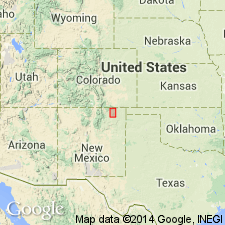
- Usage in publication:
-
- Red Mountain Dacites
- Modifications:
-
- Not used
Summary:
Map unit called Miocene rhyodacite. Yields an age of 8.1 +/-0.6 m.y. and 7.7 +/-0.5 m.y. using K-Ar method on hornblende. Name Red Mountain Dacites not used.
Source: GNU records (USGS DDS-6; Denver GNULEX).

- Usage in publication:
-
- Red Mountain Rhyodacite*
- Modifications:
-
- Geochronologic dating
- Overview
- Redefined
- AAPG geologic province:
-
- Las Vegas-Raton basin
Summary:
Is youngest Miocene igneous rock unit mapped in western part of Raton-Clayton volcanic field, Colfax Co, NM in Las Vegas-Raton basin. In addition to occurrence at Red Mountain volcano on Johnson Mesa in eastern Colfax Co, is chief rock type at Palo Blanco Mountain, Pine (Timber) Buttes, Green Mountain, Towndrow Peak, Cunningham Butte volcanoes, Raspberry Mountain, and McLaughlin Peak. Redefined--lithic designation changed to rhyodacite following the classification of La Roche and others (1980). Rhyodacite ranges from gray to orange pink or pale red, is generally nonvesicular, and has textures variously porphyritic or seriate. Phenocrysts are plagioclase and hornblende (in most cases oxyhornblende) in a hyalocrystalline, pilotaxitic, or totally glassy groundmass. Is ranges from a red and gray fluidly-banded variety having as much as 85 percent glassy groundmass to a crystal-rich porphyry having little more than 30 percent glassy or finely crystalline groundmass. Petrography and petrochemistry described. K-Ar ages range from 6-8 m.y. Age is Miocene.
Source: GNU records (USGS DDS-6; Denver GNULEX).
For more information, please contact Nancy Stamm, Geologic Names Committee Secretary.
Asterisk (*) indicates published by U.S. Geological Survey authors.
"No current usage" (†) implies that a name has been abandoned or has fallen into disuse. Former usage and, if known, replacement name given in parentheses ( ).
Slash (/) indicates name conflicts with nomenclatural guidelines (CSN, 1933; ACSN, 1961, 1970; NACSN, 1983, 2005, 2021). May be explained within brackets ([ ]).

